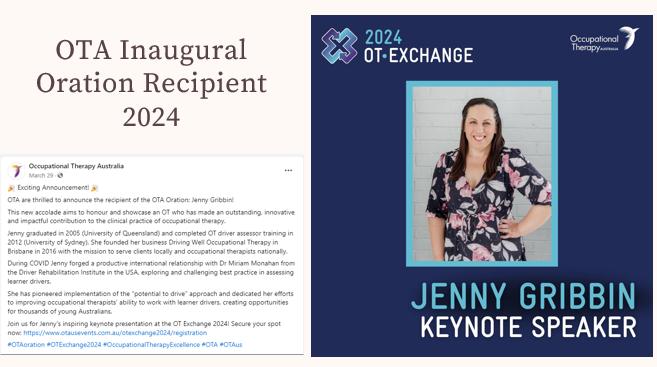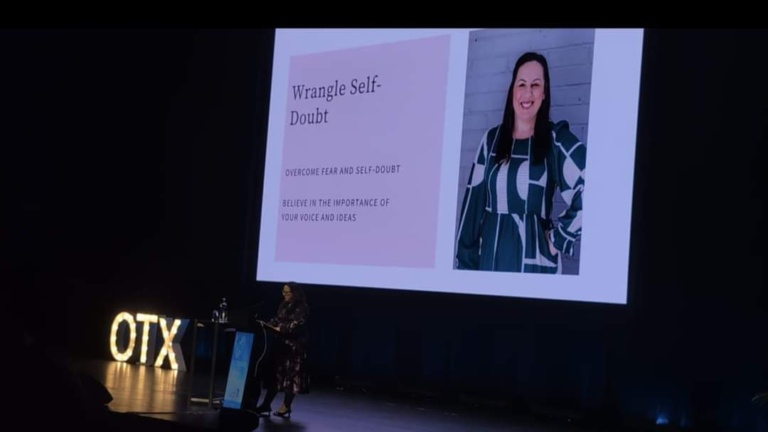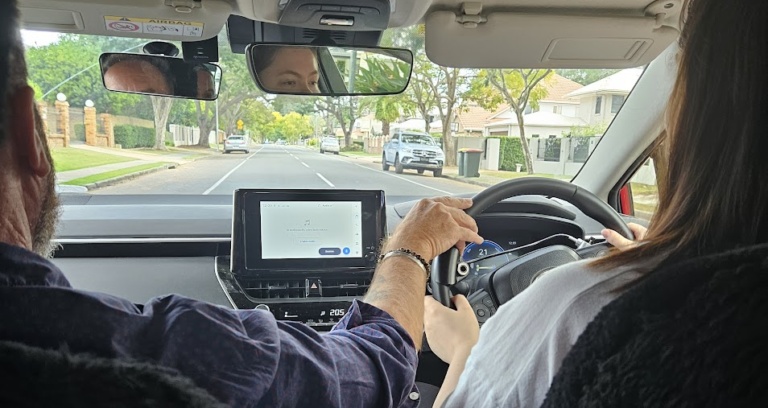I was absolutely thrilled to be the Inaugural recipient of the OT Australia “Oration” award – for a clinician who has been innovative in their work and significantly contributed to the profession of occupational therapy across Australia. The award involved providing a keynote address at the OT Exchange conference, which was held in Perth in June 2024.
We actually have a recording of the keynote address available through the Drive-Able podcast!

Applying for the award
The application process for the award included writing a personal statement, which I am going to share with you here, as it beautifully sums up my story about how I came to be working and teaching OTs in this Potential to Drive approach.
“In 2019 I advised a 22 year old woman that despite her efforts, she would likely never drive because the challenges of her disability were too severe. She was devastated. It was an awful conversation and I thought “there has to be a better way” to assess and support clients with neurodivergence and psychosocial disabilities wanting to learn to drive.
My curiosity and drive for improvement lead me to finding Dr Monahan in 2020, and with her guidance I pioneered implementation of the “Potential to Drive” approach in Australia. More than 160 driver-trained OTs and rehabilitation driving instructors have attended more than seven workshops transforming clinical practice across the country.
I also collaborated with Dr Monahan to adapt the ‘Drive Focus’ app and bring it to Australia, to date supporting hundreds of young Australians with a disability with their driving goal. I took a leap to then facilitate Drive Focus’ worldwide OT conference debut at OT Exchange in Melbourne 2022 and featured live on the Communities of Practice Facebook group, bringing the app to the attention of thousands of non-driver and driver trained occupational therapists. My work was recognised nationally winning the Australian Road Safety Foundation awards in 2021 and Finalist at Australian Disability Services Awards in 2022.
Innovation never ends: I have also developed a driving therapy program, online toolkit and webinars to support OTs and families. I’m sought after for clinical supervision, inservices, OTA Hot Topic and podcasts, and was recently featured in ABC news stories highlighting updates in licencing guidelines for autism and driving.
My contribution has indeed been outstanding and impactful to the practice of occupational therapy: Australia’s OTs are better prepared to address the question of potential to drive because of my curiosity, leadership and innovation.”

Dr Miriam Monahan
Perhaps the luckiest moment of my career was at the start of COVID, when I discovered Dr Miriam Monahan (OT driver assessor / driving instructor / researcher / lecturer / Drive Focus app developer in the USA) in a US news story online, googled her, reached out through her Drive Focus website, and was on a zoom with her within about 48 hours… our collaboration has led to running the potential to drive training all across Australia, with almost 200 OTDAs and driving instructors having now completed the training and implementing this approach into their practice.
Dr Monahan is an experienced presenter – I have had the pleasure of facilitating nine potential to drive workshops plus other webinars with her, and was ever in awe about her knowledge and how generously she shared her learnings.

Because of these neurological changes and reduced connectivity within the brain, when compared with neuro-typical teens/youth, research has found that learning to drive with autism has common challenges such as[i]:
- It is estimated that approximately 62% of the American population with ASD have high functioning ASD, more than half will pursue learning to drive, and one in three teens with ASD will become licenced drivers[ii].
- Learner drivers require three times longer to learn to drive
- Driving habits are typically that they drive less, and tend to drive more in the local area to defined routes and destinations
Autism characteristics that may impact driving include:
- reduced motor coordination: coordination of limbs for physical control (steering, braking, accelerating), and visual motor integration
- social challenges: literal interpretation of things, interpreting non-verbal cues eg lights, tailgaters, intentions of other drivers when changing lanes etc
- executive functions: often not able to see the big picture and overall understanding of traffic flow through intersections; problem solving; planning ahead; mental flexibility; divided attention
- visual search skills: “look but do not see”, focusing on the horizon versus scanning near and far, take longer to find critical information, experience cognitive overload
- Anxiety is a very common disorder associated with ASD; learner drivers found anxiety to be a barrier for learning to drive[iii]
The workshops
We aren’t giving away all the secrets in this blog post! The workshop will provide you a deeper dive into understanding the research that has been completed with driving and autism and other conditions (there is a lot that is now known). This will help you to understand how features and challenges of a person’s diagnosis may impact them, and how to best support them.
Models underpinning Potential to Drive approach
- Research evidence
- Michon’s model of driving performance – operational, tactical and strategic skills, and looking for evidence of these abilities in the young person’s lifeskills.
- Information Processing Model for driving: Vision and visual search -> information processing/decision -> execute a motor action
- Decision tree for the potential to drive assessment
The workshops
The upcoming potential to drive assessment workshop and implementation workshop, will support you as a driver trained OT to be able to understand these models, and help you to apply them during your assessments with your clients.
Potential to Drive assessment – overview
Dr Monahan has pulled all the research together and outlines an approach to enable OT driver assessors to set-up the assessment environment to minimize anxiety, optimize chance of success, provide a positive experience, and enable best clinical reasoning and decision making about “potential to learn to drive”.[iv]
Clinical assessment:
Clinical assessment is similar to the standard OT driving assessment approach, however will include assessment of visual motor integration, intelligence (where applicable) and an introduction to the “critical items” concept – the critical things we need to pay attention to as a driver.
The workshops
The potential to drive workshops will go through what assessment tools to use and common features/challenges, and clinical reasoning of the outcomes in helping you to make a decision about the outcome of the assessment.
Lifeskills review:
Parent/support worker is asked to complete a lifeskills questionnaire, to look for evidence of operational, tactical and strategic skills.
Where the young person is doing things independently in the community such as catching public transport, organizing themselves for school or a part-time job, doing household tasks such as cooking and washing, and being able to be out in the community, they are showing evidence of tactical and strategic skills which provides a solid foundation for driving.
Where a young person is completely reliant on others and unable to do basic tasks, be a pedestrian and be alone in the community (or even at home), they are not showing sufficient tactical and strategic skills for driving at the moment. Some may benefit from working on these skills with their community OT and waiting until they are a little older and more mature, to re-visit driving then; others will never have the skills for driving and are best supported to learn some community independence
The “$5 test” is a suitable indicator for readiness to drive:
Young person needs to be able to be given a $5 note and told to cross the street to go to the local shop and purchase a loaf of Tiptop multi-grain bread. At the store, they are out of this brand and the person needs to make a reasonable substitution (eg another brand of multi-grain), purchase at the check-out, make change, and return with the bread and change.
If a person cannot independently complete this task, it is likely that they are not ready for learning to drive.
The workshops
You will receive a “Lifeskills checklist” which will help you/your client/parent to rate the client’s current level of performance in a broad range of lifeskills, to help identify readiness to pursue learning to drive. And guess what – there is a brand new electronic version available, making reporting writing so easy!
Passenger activities:
Applying the research, it makes sense that a new learner driver with autism will likely become cognitively overloaded, overwhelmed and anxious, when placed immediately behind-the-wheel. It is too much to expect them to be able to learn to operate the steering wheel, indicators, follow instructions, look at where the car is in space, start to learn driving procedures…. all in a verbal/auditory learning context (when they are visual learners!).
Dr Monahan recommended that to best assess potential to learn to drive, that a series of ‘Passenger activities’ are completed – the specialised driving instructor would be driving their dual-controlled car, young person in the front passenger seat, OT driver assessor and main parent or support worker in the back seat of the car.
The passenger activities look at various components of the driving task ONE-AT-A-TIME in a structured / semi-standardised manner and provides valuable information about the young person’s ability to complete each of these tasks.
Breaking down the underlying tasks required for driving provides the OT Driver Assessor a much better look at the Participant’s ability, without putting them under cognitive overload or too much anxiety. This method also enables assessment of potential to learn, when the young person is a pre-learner and is interested to see if it is worthwhile / feasible for them to pursue obtaining their Learner’s permit.
The workshops will explain:
- What the four passenger activities are
- How to complete them
- How to rate the client’s performance in these
- Use case studies to demonstrate these
- Develop clinical reasoning skills
Behind-the-wheel
For learner drivers, I usually include a short behind-the-wheel assessment – even if it is the first time, we are able to gauge ability to follow instructions, ability to put a few things together (steering, scanning, following procedures, problem solving and ability to make little improvements).
Decision / outcome of assessment
The decision tree provides a framework for pulling all of your results together, to be able to make a recommendation about your client’s potential to continue with learning to drive. There are four possible outcomes:
- Ready now without need for additional supports (mainstream approach)
- Ready now but due to challenges from disability needs specialized support (this likely includes a specialised driving instructor and driving therapy with OTDA, as well as input from general OT, and other AHPs, and family/support workers).
- Not ready for driving yet: needs to work on all pre-driving skills and try again in the future
- Not for driving: challenges from the disability are severe and they need support to develop community mobility independence.
The workshops
The assessment and implementation workshops will help you to develop clinical reasoning skills to work out where your client sits on this decision tree, and make recommendations to the client and family.

Call to action
If you are an OT driver assessor or specialised driving instructor working the disability learner driver space, and you haven’t done this training before, then you need this training!
We would love you to join us, and we would love to support you with your learning as you implement this approach into your practice, and provide the best support that you can for your clients.
Online Potential to Drive assessment workshop
Details: Wednesday 30th October AND Friday 1st November, 2024, 9am – 1pm BOTH days.
It will not be recorded!
Register here: https://www.trybooking.com/CPOTT
Sydney – in person – Potential to Drive implementation workshop
Best to have attended the assessment workshop.
Details: Friday 22nd November, 2024, 9am – 1pm
Location: Oatlands Golf Club, Oatlands NSW 2117
(Minimum 10 participants – otherwise the workshop will be rescheduled!)
It will not be recorded!
Register here: https://www.trybooking.com/CQOIV
[i] Curry, A. E., Yerys, B. E., Huang, P., & Metzger, K. B. (2017). Longitudinal study of driver licensing rates among adolescents and young adults with autism spectrum disorder. Autism, 1-10. doi:10.1177/1362361317699586
[ii] Autism and Developmental Disabilities Monitoring Network 2012, Huang et al 2012, Curry et al 2017.
[iii] Chee, D., Lee, H., Patomella, A., & Falkmer, T. (2017). Driving Behaviour Profile of Drivers with Autism Spectrum Disorder (ASD). Journal Of Autism And Developmental Disorders, 47(9), 2658-2670. doi: 10.1007/s10803-017-3178-1
[iv] Monahan, M., Classen, S., & Helsel, P. (2013). Pre-driving evaluation of a teen with attention deficit hyperactivity disorder and autism spectrum disorder. Canadian Journal Of Occupational Therapy, 80(1), 35-41. doi: 10.1177/0008417412474221
